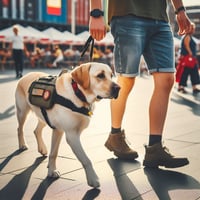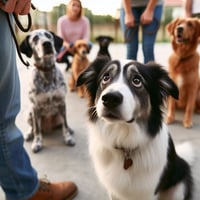Bringing a recently rescued large dog breed into an urban setting can be an exciting yet...
Redirect a Dog from Prey: A Guide Using Food and Toy Drive

Dogs with high prey drive can become fixated on small animals like birds, squirrels, cats, or even small dogs. While this instinct is natural, uncontrolled chasing can be dangerous for both the dog and the animals involved. The key to managing prey drive is redirection—using a dog’s food or toy motivation to focus their attention on something more rewarding before they react to the trigger.
The Power of Timing: Reward Before the Reaction
One of the biggest mistakes owners make is waiting until their dog is already lunging or fixated before trying to redirect them. At this point, the dog’s brain is fully engaged in the chase mode, making it much harder to regain control. Instead, the goal is to capture the dog’s attention before they react.
Step 1: Identify the Trigger Distance
Every dog has a threshold—the distance at which they first notice the small animal but have not yet reacted. Observe your dog’s body language to recognize this point: ears perking up, body stiffening, or staring. Once you identify this distance, this is where you should begin your redirection training.
Step 2: Use High-Value Food Rewards
If your dog is food-motivated, carry irresistible treats like pieces of cooked chicken, cheese, or freeze-dried liver. Before your dog fixates on a small animal, say their name and immediately reward them for looking at you instead. The goal is to teach them that focusing on you brings a higher reward than chasing.
Example: You're walking your dog, and you see a squirrel 20 feet ahead. Before your dog locks onto it, you call their name and immediately offer a high-value treat. Over time, your dog learns that looking at you instead of the squirrel earns them something delicious.
Step 3: Engage Toy-Driven Dogs with Play
For dogs with strong toy drive, redirect their energy onto a favorite toy, such as a tug rope or ball. This works especially well for herding and working breeds that enjoy chasing and catching objects.
Example: You’re at the park, and you notice birds nearby. Before your dog focuses on them, pull out a tug toy and engage them in a quick game. This redirects their instinctive chase drive to an appropriate outlet while reinforcing engagement with you.
Step 4: Introduce a Trained Cue
Teaching a reliable “Leave It” or “Look at Me” command can be a game-changer. Start practicing in low-distraction environments, gradually working up to areas where small animals are present. Always reward compliance generously.
Example: Your dog spots a cat but hasn’t started chasing yet. You say, “Leave It!” and the moment they turn to you instead, you reward them with a treat or toy. Repeating this consistently teaches your dog that ignoring the prey animal is highly rewarding.
Consistency and Gradual Exposure
Redirecting prey drive isn’t a one-time fix; it requires consistent training in various environments. Start in low-distraction areas and gradually increase difficulty as your dog improves. With patience and the right rewards, your dog will learn to choose engagement with you over chasing small animals.
By anticipating your dog’s reactions and rewarding them before they fixate, you set them up for success—making walks and outdoor adventures safer and more enjoyable for both of you!
Interested in getting help with socialization or public access training for your urban pup? Check us out at https://socialdogsllc.com!
.png?width=50&height=50&name=Profile%20round%20logo%20(1).png)


